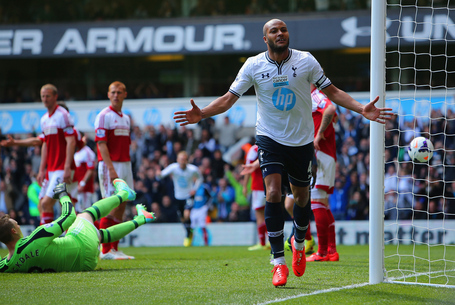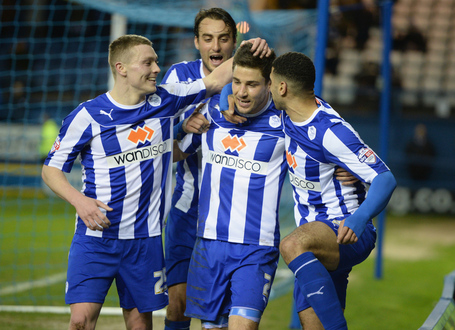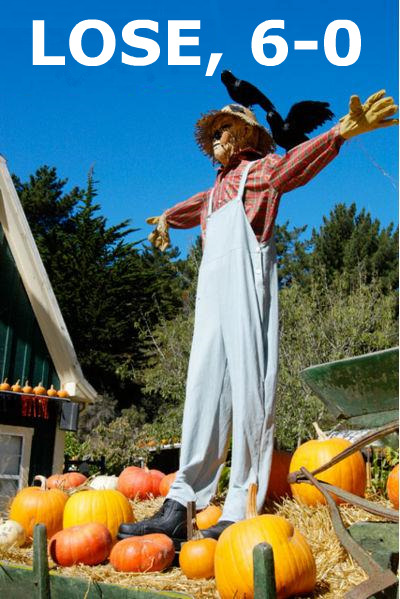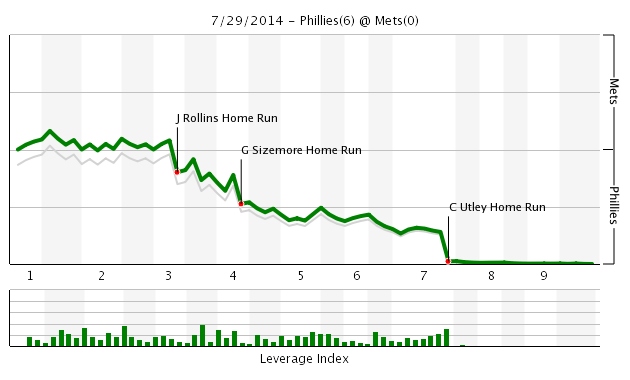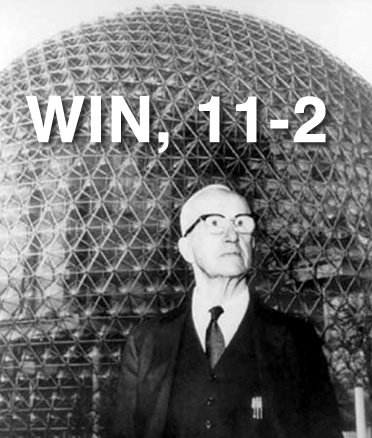
Rumors are swirling that the Mets have interest in the Rockies' superstar shortstop, but is he worth trading for?
With the news last week that the Mets had made their interest in Troy Tulowitzki and Carlos Gonzalez known to the Rockies, a great amount of debate sprung up regarding whether the cost would be worth it. Those of you who saw my comments know where I stand, but I will do my best to be objective in the analysis portion of this post before attempting to brainwash you with my conclusions at the end.
![]() Must Reads
Must Reads ![]()
![]() Must Reads
Must Reads ![]()
First things first, what pieces do the Rockies want from the Mets? While it's impossible to pin down exactly what it would take, we can make a reasonable approximation. Former Mets GM Jim Duquette thinks it'll take at least Zack Wheeler, Rafael Montero, Dominic Smith, and more. Another package I've seen bandied about is Noah Syndergaard or Wheeler, Brandon Nimmo, Kevin Plawecki, and Smith, with many other variations cropping up. Four Top 100 prospects, all of whom have been included in the Top 50 of one list or another and two of whom are Top 50 by general consensus—this seems like a reasonably fair package.
I will reiterate the disclaimer I made above before continuing. It is impossible to know who the Rockies want exactly. The resulting analysis could be completely thrown off based on the opinions of Rockies' scouts and which Mets prospects strike their fancy. They hold basically all the bargaining power if Mets' management really wants to complete a trade. With that in mind, let's press forward.
Troy Tulowitzki has been the best shortstop in baseball for a while, and is having an even more ridiculous season this year. He's mashing an absurd .340/.432/.603, good for a 172 wRC+. His defense has also been a plus, leading to a compiled 5.1 WAR in only 375 PA. He was having a healthy season before tweaking his quad, and if his personal statements are to be believed, the injury is nothing serious and the Rockies are simply playing it safe because they're awful. He's on pace for a 7-8 WAR season, and is, in a word, awesome.
However, the Mets are not trading for Tulo's past or present. They're trading for his future. What does the value look like? The table below shows his salary and projected WAR. For an established player like Tulo, I will suspend my disbelief of the Oliver projection system (I'm not a fan) and live with their numbers, because they are the best resource available. Those numbers only go out to 2018, so I projected a decline I feel is reasonable for 2019-2021.
Year | Salary | Projected WAR |
2015 | $20M | 5.4 |
2016 | $20M | 5.1 |
2017 | $20M | 4.8 |
2018 | $20M | 4.5 |
2019 | $20M | 4.0 |
2020 | $14M* | 4.0 |
2021 | $15M* Option ($4M Buyout) | 3.5 |
*these values will likely be $20M or more due to escalators in his contract
Hot diggity, that's a lot of WAR in the next 5 years. But before we embrace these numbers fully, let's step back and make a couple observations. Oliver projects an 11.9 defensive value (2014 tally) forward for each of the next 7 years. Given his many nagging injuries, the inconsistency of defensive metrics, and general aging, this is simply not realistic. Knock some WAR off for that. The second, bigger problem to me is that Oliver projects 600 PA every year. Given Tulo's injury history, this is most certainly not reasonable, especially as he ages. But even with those caveats, Tulo is probably going to be an awesome player.
Now, let's look at how we fill our holes after this trade. We'll have lost a pitcher who was projected to be in our rotation for 2015 and our starting LF for 2016 and beyond. These are holes we'll have to fill with money. Though things don't exist in a vacuum, let's fill those spots with a Ruben Tejeda equivalent—a 1.0 WAR player who costs $500,000. Plawecki and Smith don't cost us anything in terms of production, but I will touch on the loss of depth later.
What value would these prospects have brought to the Mets? Let's start with Thor, our major league-ready God of thunder. Here, Oliver projections fail us, as they are pretty awful with projecting prospects. Instead, we'll have to suspend disbelief and make our own numbers. For Syndergaard, I will try to be conservative and say he follows the Wheeler path rather than the Harvey one, settling in as a top-of-the-rotation arm by late 2018. Assuming he comes up late this year (putting him on track for free agency in 2021), that value is shown in the table below.
Year | Salary | Projected WAR |
2015 | $500K | 2.1 |
2016 | $500K | 2.5 |
2017 | $500K | 3.0 |
2018 | Arb. 1 | 3.5 |
2019 | Arb. 2 | 4.0 |
2020 | Arb. 3 | 4.5 |
2021 | FA | 4.5 |
My WAR projections won't be perfect, but I think they accurately reflect Syndergaard's ceiling. But that is also a problem; prospects bust, even Met prospects (shocking I know). Thankfully, we have data on the bust rates of top prospects. As a Top 20 pitching prospect, Syndergaard has a bust rate of about 63%. Given his command profile and the fact that he's been knocking on the door of Top 10 status, we can optimistically push that number to about 55%. Still, that is a huge bust rate, and we shall have to discount his WAR as a result.
As for salary, we'll again have to suspend our disbelief. Say he makes $30 million in those three arbitration years and the Mets get a nice bargain on his 2021 salary with an early career extension at $15 million. Again, optimistic, but this isn't a precise science. That gives us a projection of 24.1 WAR at a cost of $46.5 million with a large bust rate of 55%. There are several obvious problems here (money is not precise, bust rates are based on historical data when public top prospect lists were not as popular or accurate), but it will do as a rough estimate.
For Nimmo, the comp I've always used (and seen others use as well) is Shin-Soo Choo. Choo didn't get his first real shot until 26, but his skill set is similar to Nimmo's. Choo probably has a tad more power but was a poor corner outfielder, while Nimmo should be an above-average LF (or even a decent CF, but that's not the scenario we're considering here). Again, these are homemade WAR projections, but they will do as a rough estimate.
Year | Salary | Projected WAR |
2015 | $500K Prorated Upon Callup | 0.5 |
2016 | $500K | 2.0 |
2017 | $500K | 2.5 |
2018 | $500K | 3.0 |
2019 | Arb. 1 | 4.0 |
2020 | Arb. 2 | 4.5 |
2021 | Arb. 3 | 4.5 |
As a Top 50 prospect with high strikeout and high walk totals, Nimmo's bust rate is around 65%. As a Nimmo fan, that hurts. For salary, let's say he makes $25 million in his three arbitration years, which yields a total of 21 WAR at a cost of $26.5 million. Again, greatly simplified at every step of the approximation, but a reasonable projection to work with.
I did not concern myself with projecting Plawecki and Smith. Their impact on the Mets is more an effect of having depth (more on that later). Smith in particular is so far away and plays the easiest position on the field, so projecting him to determine what value he adds in this time frame when a replacement could be found relatively easily is a pointless exercise. To finish this scenario, we of course have our Ruben Tejeda of shortstops, also known as Ruben Tejeda. 1.0 WAR at $500,000. Bleh.
Lets's compare scenarios now by comparing the production we get from the shortstop and left field positions and 1 starting pitcher slot over this time span:
Scenario 1 | Scenario 2 | ||
SS WAR | 31.3 | SS WAR | 7.0 |
LF WAR | 7.0 | LF WAR | 7.35 |
SP WAR | 7.0 | SP WAR | 11.30 |
Total WAR | 45.3 | Total WAR | 25.65 |
Total Cost | $147M | Total Cost | $80M |
WAR/$1M | 0.31 | WAR/$1M | 0.32 |
What do we make of this data? With all the caveats and restrictions on projections I've mentioned as we worked through the logic, our final case comes out almost equal in terms of WAR cost-efficiency. Scenario 1 guarantees more WAR, and ignores the potential contribution of other prospects like Michael Conforto and Steven Matz, plus gives us the bona fide superstar the fan base has long been lusting for.
But this is not the end of our analysis. If just one of either Nimmo or Syndergaard reach their ceiling, the WAR efficiency swings even further in favor of Scenario 2 and brings the total WAR much closer to an even mark, even if the other busts completely. Furthermore, we've reached our greater WAR in Scenario 1 by trading two other assets in Plawecki and Smith, sacrificing depth that could be used if d'Arnaud's hot streak is just a hot streak or that could have been traded in another deal. Scenario 2 also neglects contributions at SS from Amed Rosario or Gavin Cecchini down the line, or from sketchier candidates like Matt Reynolds and Wilmer Flores. No risk has been factored into Tulowitzki's projection either, and there is undeniably a decent amount of risk there given his injury history and the fact that he would have to adjust to leaving Coors Field (though I think this latter point is not much of a problem). Finally, that additional financial burden could seriously impede the Mets' ability to retain their young stars.
At this point, my bias is probably obvious. I began writing this post heavily opposed to the idea of trading for Tulowitzki, as awesome as it would be to see him playing shortstop next to David Wright. The numbers are not nearly as stark as I expected them to be, and I was probably a tad optimistic in my projections for Syndergaard and Nimmo in terms of WAR and possibly salary. Still, I stand by my conclusion. Sandy Alderson has done a fantastic job of building up our farm, and the pipeline of talent is almost about reach the major leagues. I am loathe to sacrifice our depth when it is this very system that has consistently kept teams like the Braves and the Cardinals in contention year in and year out, particularly for a player with significant injury concerns who will soon enter his decline phase.
I know people will mention some big trades to disprove the point that the best teams don't make these kinds of acquisitions. The Matt Holliday, Miguel Cabrera, and Mark Teixeira trades are three cases I'd like to look at to further justify my position and hopefully change this opinion.
When the Cardinals acquired Matt Holliday in 2009 from Oakland, he was a 29-year-old masher having a down season on an expiring contract. To get him, they gave up one top prospect in Brett Wallace (ranked 40th by Baseball America), and then two additional, complementary pieces. This is the equivalent of trading Brandon Nimmo, a pitcher like Casey Meisner, and a throw-in of some kind. They then gave Holliday a massive contract in free agency. This was a fantastic deal for them. They acquired a slugger with 2-3 years of prime left for mostly financial cost, while only depleting their depth minimally. To acquire Tulowitzki, we'd have to both destroy our depth and pay the huge deal, not to mention that a good deal of Tulo's value is tied up in his ability to play shortstop and that Holliday had nowhere near the injury history that Tulowitzki has.
The Tigers traded one Top 10 prospect (Cameron Maybin) and one former Top 10 prospect (Andrew Miller) for Miguel Cabrera in 2007. A Met equivalent of the total package they gave up is probably along the lines of what we're considering sending the Rockies for Tulowitzki. The key difference is that Cabrera was only 24 and already hitting like a Hall of Fame player. The Tigers traded for a player with no injury history and an absurd major league resume for his age, and they then got the best years of his career. Tulowitzki isn't ancient, but he isn't young either. He will soon enter the decline phase of his career, and playing the hardest position on the field with all his nagging injuries will take its toll. If he was 24, I would drive that prospect package with Herrera strapped to the roof of my car to Colorado tonight. But he's not.
Lastly, the Mark Teixeira trade. The Braves acquired a 27-year-old Mark Teixeira in 2007 with 1.5 years of team control left. They gave up Elvis Andrus, Jarrod Saltalamacchia, Matt Harrison, Neftali Feliz, and Beau Jones. They then traded him to the Angels a year later and got...Casey Kotchman. Oops. This is an example of how giving up huge prospect packages can backfire immensely. The Braves gave the Rangers a good starting pitcher, a shutdown reliever, a solid catcher (though he bloomed outside of Texas), and one of the better shortstops around for 1 year of Teixeira, got nowhere, and then were unwilling to pay him in free agency. Arguably one of the worst trades of the past decade and certainly the worst in Braves history, it should serve as a cautionary tale for Met fans gung ho to get Tulo.
I'll close my argument with a quote from Jurgen Klinsmann, a rather controversial comment he made about Kobe Bryant when justifying his decision to leave Landon Donavan of the World Cup roster:
"This always happens in America. Kobe Bryant, for example - why does he get a two-year contract extension for $50 million? Because of what he is going to do in the next two years for the Lakers? Of course not. Of course not. He gets it because of what he has done before. It makes no sense. Why do you pay for what has already happened?"
The highlighting is my own, to pull out the point I'm trying to make. I am not suggesting that Tulowitzki would be as great a drain as Kobe is to the Lakers, but the idea is valid. Do not trade our bright future for what Tulowitzki has done in the past. Trust in our development and target smaller trades (CarGo might even be a better option, if the cost is reasonable) that supplement our rising, young core.
In short, say no to Tulo.
Prospect bust rates based on http://www.royalsreview.com/2011/2/14/1992424/success-and-failure-rates-of-top-mlb-prospects">this article at Royals Review. A more accurate method may have been to create three different scenarios—bust, success, superior—in projections and then take the weighted averages of each. Unfortunately, time is a finite resource.








